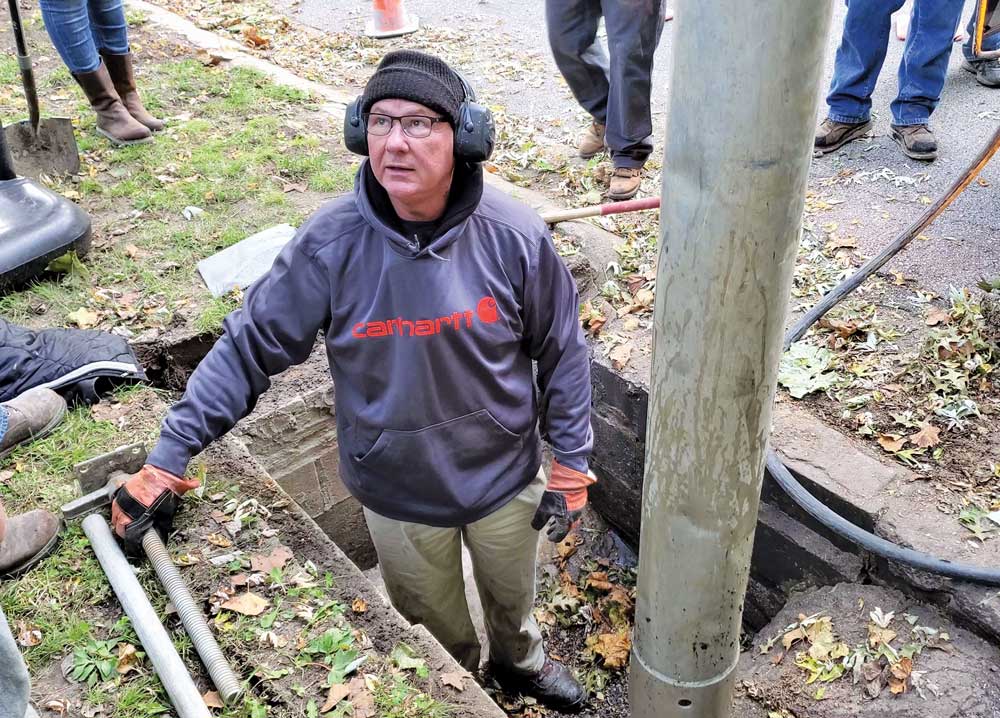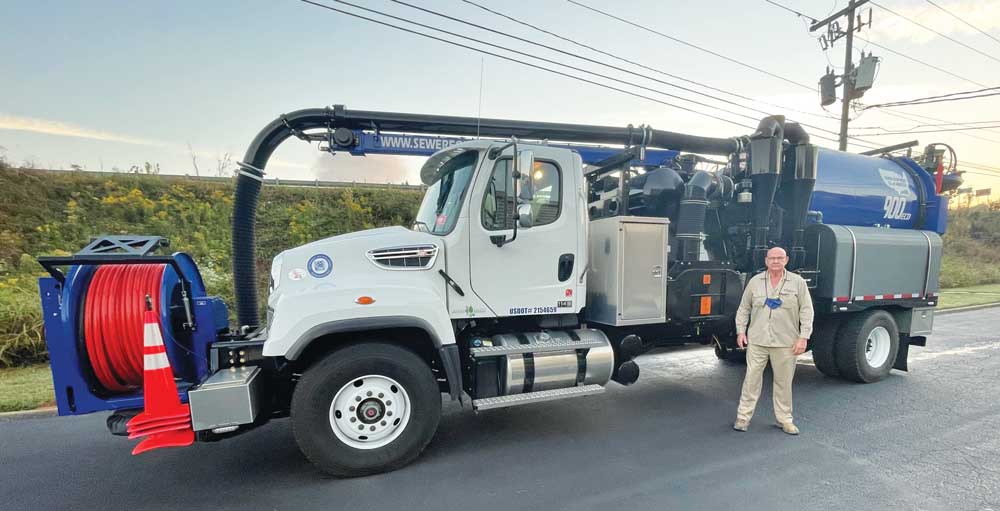
Sewer Cleaning 101 – Rusty Nezat’s Goal Is to Keep ‘Dung Beetles’ Safe
Since starting in the sewer cleaning industry in his early teens, Malvin “Rusty” Nezat II has always known the importance of proper training and its role in keeping crews safe and the work optimized.
The Louisiana native began working at the age of 13 for his dad in the family’s sewer cleaning business. Nezat remembers complaining about the bad odor coming from the sewers to which his dad replied, “Son if it don’t smell, you ain’t going to make any money. Just hold your nose.”
The Start of a Training Career
He worked for his dad for several years before leaving the family business to work for Insituform in Texas. There, he worked doing sewer cleaning and that is where he first realized there was a science to sewer cleaning. The company sent him to a continuous improvement process training class and Nezat was intrigued by what he learned. Intrigued to the point that he requested time off work to build a sewer pipe that he could add sediment to, put nozzles in, and video it to see what was actually happening in the pipe.
“I took what I learned [from my model] and we built our own program to teach our sewer guys, who ran about 12 trucks cleaning for the City of Houston. After the training, our production doubled within two weeks because we got it down to a science. We took a lot of the guesswork out of it,” he recalls.
After leaving Insituform he started Nezat and Associates in 1991 and in 1999 changed to Nezat Training and Consulting Inc. to take this knowledge and offer it to contractors and municipalities involved in sewer cleaning, inspection and rehabilitation across the United States.
Those early years were marked by working out of the small bathroom in his house. And it’s grown to include a dedicated production facility called Dung Beetle Studios to produce training videos for the industry at-large.
RELATED: Pipe Cleaning Project Takes Crew Across Texas Golf Course
“My office was in my bathroom, I had to sit on my toilet and had a little desk and that’s where I did all of my business…no pun intended. I made all of my phone calls from in there,” he says. “We just kept growing and growing and developing programs and the technology came along and we digitized everything and now we offer an on-demand LMS and Zoom-based sewer training, as well.”
It’s clear when talking to Nezat that he takes great pride and personal responsibility in getting out and training the sewer cleaners, who he light-heartedly refers to as dung beetles, across the country. He does so not only to help them do their jobs better but more importantly with a focus on safety. It’s the latter that takes the often-jovial Nezat to strike a serious tone.
“The safety aspect…I’ve been doing this for so long now…as I travel the country, I have seen needless deaths in our industry because there was no training…none,” he says. “I’ve trained thousands of people now and I always ask them if they have received any documented or accredited training about what can happen to them with a sewer nozzle, a plug, or any other equipment. And many never have.”
That, he says drove him along more over the years to evolve his training offerings and focus squarely on the sewer cleaning process. His online training programs are now accredited in 25 states — with a goal of getting to all 50 states — for 7 hours of continuing education hours. It is also accredited by the Center for Underground Infrastructure Research and Education (CUIRE) at the University of Texas at Arlington.
While Nezat is a member of many associations and organizations involved with the sewer cleaning and maintenance industries, he notes that most of his training is direct with contractors or system owners. He has presented at events like the Tri-State Seminar and the precursor to the WWETT Show.

Safety in Sewer Cleaning
“As I traveled the country, I came in contact with these — I call them dung beetles, because they keep the poop moving — I heard horror stories of people with horrible injuries because no one ever taught them about the dangers involved in the sewer cleaning process.,” he says.
One area he highlights in our discussion is the safety aspects surrounding pneumatic plugs. People, he says, for instance, don’t realize that a 30-in. pneumatic plug that’s rated at 25 psi, when fully inflated, contains 500,000 lbs of force. They don’t realize the damage that can be done if a plug ruptures. Or on the nozzle side, Nezat once spoke to a sewer cleaner who had the nozzle come out of a surcharged sewer pipe and cause bodily harm.
“These stories can go on and on,” Nezat says. “If these people had the proper training, they would have known how to proceed in those situations in the safest way possible. The in-depth training is not [readily] available.”
Nezat’s goal with his company is to take the knowledge he has about the science of sewer cleaning and his field experiences and create an educational and entertaining training program that gets into the details of sewer cleaning. “I trained [to be an entertainer] because if you can’t make it fun and you can’t pull them in, you’ll lose them,” he says.

Keeping it Entertaining
Unlike other training, which might be a handbook and a presentation with a few PowerPoint slides, Nezat prides himself on creating visual materials that show the student what is taking place in the field. Nezat’s goal is to make the classes accessible for everyone no matter their educational level.
“There was one time, early on, where I was doing a training [session] without a lot of visual aids and I realized that there was something horribly wrong,” Nezat recalls, once again striking a serious tone. “I walked to the back of the room and asked the class to take some notes and that’s when I realized that 90 percent of the people couldn’t read or write. I was horrified. After that, everything I taught was in a visual form. Everything is a picture or video.”
He is also a lifelong learner, getting new information and insight out of every class he teaches. He notes that there are times that he’ll have a chat with someone who is taking his class — before the class has begun — who questions what they could possibly learn from Nezat that they have not already encountered in the field.
“I’ve had people tell me they have done this work for 35 years and that there isn’t a damn thing I could teach them,” Nezat says. “I’ll say, ‘I am so sorry you have to sit through my class, but I’ve been doing it a long time too and I don’t know everything. I intend to learn something from you, so I hope you interact with me while I am teaching. If I am saying something wrong, go ahead and correct me.’”
RELATED: Issues that Affect the Cost of Sewer Maintenance and the Quality of Sewer Cleaning
Taking it Online
Prior to the COVID-19 pandemic, much of Nezat’s work was in-person classroom and field training. In the last year and a half, because of the pandemic, Nezat has not been able to get out to many municipalities because onsite training was stopped to help slow the spread of the virus. Like many companies, Nezat pivoted to adding Zoom-based training.
“In the last year or so we’ve gone to our online learning management system (LMS). You watch a module with a video and answer test questions [at the end of the module]. Then cities started asking for Zoom training and we reconfigured our studio so that we can do that,” Nezat says.
The online courses — like his in-person classes — are broken into segments that progress through the sewer cleaning process. The videos, each about 10-15 minutes long, are followed by a test. Successfully completing a module allows the person to move on to the next module. He knocks out the safety components first and then gets into the operations training.
“Plugs are the No. 1 incidence of people being hurt followed by high-pressure hose [incidents] so I want to get that out of the way before I start into the building blocks,” he says. “Then we go into nozzles, how to clean the sewers, high-pressure pumps, and so on. My goal is to add another 10 hours of programs.”
He is also looking at adding training that focuses on operating easement reels, wet well cleaning, large-diameter cleaning, equipment optimization and manhole opening. Also, on the horizon is working with colleges and trade schools to get this training out there to people who are making career decisions, so when they leave school, they are fully prepared to enter the industry and get to work.
“I love doing this. This is what I want to spend the rest of my life doing. So my goal, before I kick-off is to get everything that is in my head, out of my head, and on video so I can leave it for this generation and the next generation,” he says.
While Nezat would love the opportunity to train everyone in the United States, he knows that’s not possible. He urges contractors and cities to think about the liability involved with not training their people properly. With that in mind, he says that it’s imperative that cities and contractors engage in some form of hands-on sewer cleaning training before sending people into the field.
Mike Kezdi is managing editor of Trenchless Technology.




